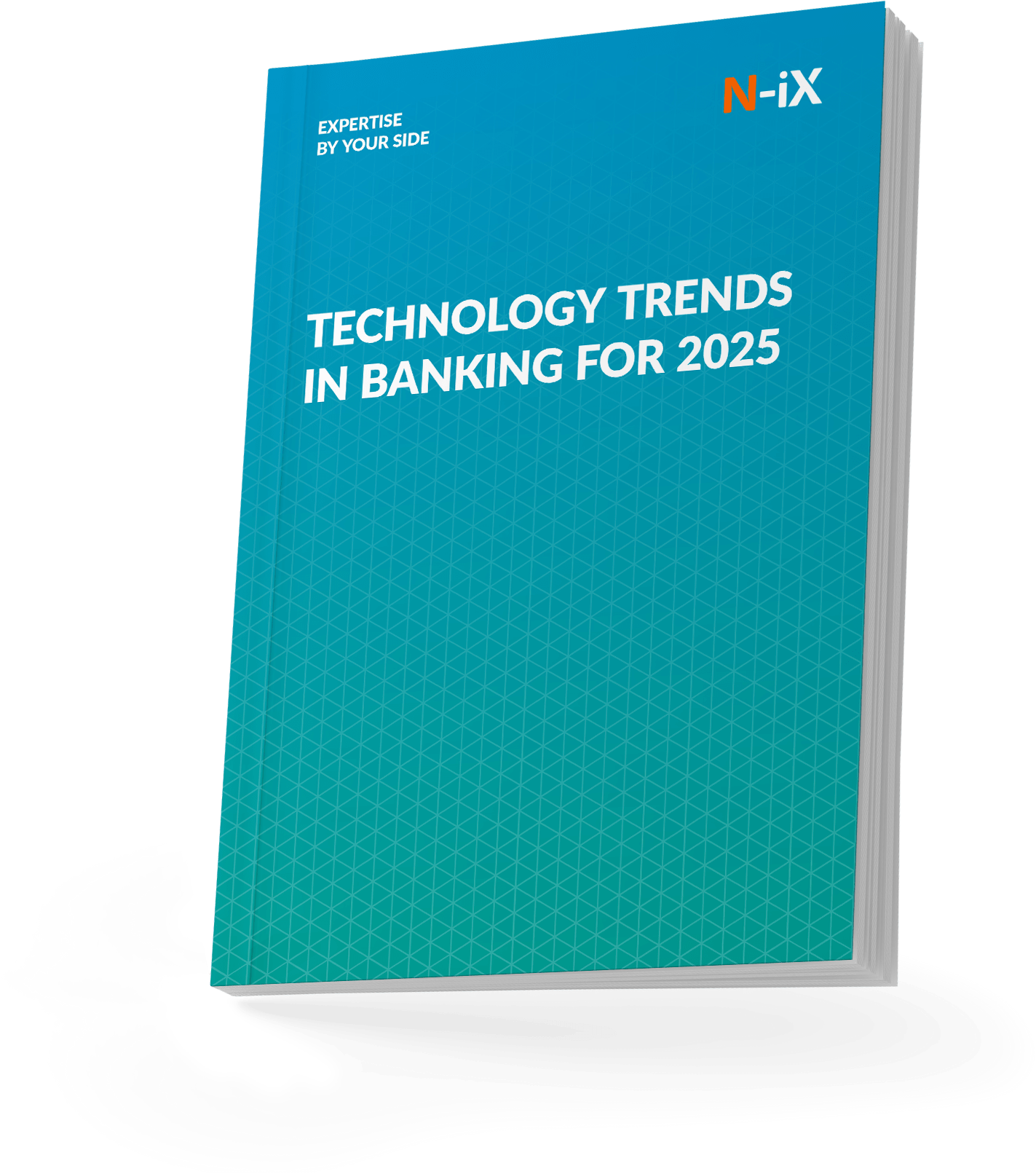Financial institutions wield huge volumes of data that can be used to deliver better customer experiences, boost revenue, and mitigate risks. Predictive analytics in banking software development helps navigate uncertainty and build operational resilience. Today, employing multiple data analytics solutions is the industry standard. By 2033, the market for predictive analytics in banking is estimated to reach $19.6B, an over five-fold increase from 2024. With this degree of competition, it is critical to build solutions that are accurate, scalable, customizable, integrated with existing systems, and offer robust data security.

Let’s learn what purposes predictive analytics serves in banking and how to build a reliable and scalable solution.
How is predictive analytics used in banking
First, what is the difference between different data analytics systems? There are four levels of data processing ranging in complexity:
- Descriptive is the simplest form of analytics. It summarizes historical data to answer the question, "What happened?" It uses tools like reports, dashboards, and visualizations to provide an overview of past performance or events.
- Diagnostic analytics builds on descriptive analytics and goes deeper to uncover the reasons behind certain outcomes, answering the question, "Why did it happen?" It uses techniques like root cause analysis, correlation, and pattern detection.
Read more: Business intelligence in banking: track, infer, project
- Predictive uses statistical models, ML, and historical data to understand the internal rules of the data and forecast future outcomes, saying, "What is likely to happen?"
- Prescriptive analytics is an advanced level of analytics that provides actionable recommendations. It answers the question, "What should be done about it?" It leverages optimization algorithms, simulations, and decision trees to suggest the best course of action.

Statistical models are versatile and can be designed to predict virtually any variable as long as sufficient and relevant data is available. However, certain applications are particularly valuable. These common applications include:
Customer relationship management
According to Global Newswire’s report, CRM is the most dominant use of predictive analytics in banking, with 30% of enterprises employing it. These models predict purchases, engagement, risk level, and churn and accurately segment customers. This enables businesses to deliver highly personalized experiences, such as targeted marketing campaigns or tailored product recommendations, increasing customer satisfaction and loyalty.
Read more: A guide to personalized banking implementation
Risk-based crediting
Better loan quantification allows banks and financial institutions to offer tailored loan terms, such as interest rates or credit limits, that reflect the borrower’s risk profile. Predictive analytics in retail banking use data on income, credit history, spending patterns, and other relevant metrics to predict the likelihood of default or timely repayment.
AI significantly enhances credit risk estimation by enabling faster and more accurate decision-making through the analysis of vast amounts of data, including unstructured information.
Learn more about implementing AI in credit risk management
Fraud detection
To use predictive models in fraud detection, the model learns patterns typical of fraudulent activities and distinguishes them from legitimate behavior. When a new transaction occurs, the model analyzes its features and compares them to the learned patterns. It then assigns a probability score indicating how likely the transaction is to be fraudulent. If the probability score exceeds a predefined threshold, the transaction is flagged for further review. Lower scores may be accepted as legitimate or monitored for additional context.
As new data comes in, the model refines its predictions to accommodate emerging fraud patterns. In real-time systems, this enables immediate detection and intervention for potentially fraudulent transactions.
Other uses
Predictive analytics in banking extends to cash flow forecasting, investment portfolio management, operational efficiency, and compliance monitoring. It helps banks anticipate liquidity needs, personalize recommendations, predict ATM cash replenishment, and identify potential regulatory violations.
Regardless of a specific use case, developing a robust model follows the same universal methodologies. The techniques and best practices for creating high-quality models are applicable no matter the specific type of data or banking application because the machines are indifferent to what the numbers they analyze represent in the real world.
Building a predictive analytics solution
Building a predictive analytics model for banking is a structured, data-centric process that empowers financial institutions to make informed decisions and anticipate future trends. Here are the four steps that it takes to benefit from predictive analytics in the banking sector:

Partner with N-iX to gain access to top expertise in financial predictive analytics development
N-iX is a trusted partner for financial predictive analytics development for several reasons:
- Expertise: With a pool of over 2,200 professionals and 200 experts in Big Data engineering, BI, Data Science, and AI/Machine Learning. Our analysts will help you assess your business context, develop KPIs, and provide realistic estimates. We have a proven track record of delivering over 250 projects for BFSI clients, from platforming to complex automation.
- Over 22 years serving enterprises: We support fintechs, banks, and financial institutions in bringing innovation and excellence to financial software. We've partnered with leading enterprises and Fortune 500 companies to launch and scale their Data Analytics initiatives.
- Regulation compliance expertise: We are compliant with international regulations, including ISO 27001:2013, PCI DSS, ISO 9001:2015, and GDPR, and have proven experience working with industry regulations and standards.
Step 1: Data collection
During data collection for a predictive model, one gathers and preprocesses data to ensure its quality and relevance. A key decision involves choosing the type of data pipeline: real-time, near-real-time, or periodic data collection:
- Real-time data pipelines continuously feed the model with up-to-the-moment data, making them ideal for applications like fraud detection, where immediate action is critical.
- Near-real-time data offers a slight delay, which is often sufficient for applications like dynamic pricing or customer segmentation, which balance timeliness with processing efficiency.
- Periodic data collection involves updates at scheduled intervals, which is suitable for less time-sensitive tasks like quarterly risk assessment.
These choices significantly impact the model’s design, computational demands, and operational performance, making it vital to align them with the specific business objectives and technical constraints.
Step 2: Data preprocessing
Raw data has to be translated into a unified format that can be effectively used by the algorithm. It bridges the gap between data collection and model training by addressing data quality issues and preparing it for analysis.
Clear standards should be established to define "good data." Setting benchmarks for completeness, consistency, accuracy, and relevance ensures that the data used in analytics projects is reliable and fit for purpose, reducing the risk of flawed insights.
Strict documentation of data sources, transformations, and decisions during preprocessing ensures transparency and accountability and enables future audits. This structured approach minimizes errors, supports better decision-making, and builds trust in the predictive models being developed.
Step 3: Feature engineering or model training
The third step requires bridging domain knowledge with data science expertise, ensuring that the model better captures the relationships in the data. It will look different depending on the type of model chosen:

Traditional models require explicit and manual feature (variables or inputs) engineering because they rely heavily on carefully crafted input weighting to capture relationships in the data and make predictions. On the other hand, AI models need minimal manual feature engineering because they can learn complex patterns directly from raw or minimally processed data. However, this comes at the cost of model explainability, which is necessary in finance. Techniques such as sensitivity analysis and model-agnostictools like SHAP and LIME reveal the importance of features and the influence of individual parameters on predictions.
We prepared a complete guide to From Big Data to big opportunities: Data analytics in banking
How the model will be integrated into the decision-making process also has to account for its type and degree of explainability. AI performs best in concrete value predictions based on vast and diverse data, while simpler rule-based models are best at processing little data for complex decision trees. A model's business benefits are often determined by how well its training was designed. Good data design allows models to extract maximum predictive insight.
Step 4: Deployment and lifecycle management
Implementing predictive analytics in banking requires a structured, step-by-step approach that entails careful planning, robust technical infrastructure, and smooth system integration. Several experts contribute to the process, starting with data engineers who handle data migration and integration. Next are DevOps engineers, who connect development and operations, followed by cloud experts, data scientists who validate the model, and finally, security specialists.
Once the models are ready, developers integrate them with the bank’s existing systems using APIs, which allows different software to communicate smoothly. The models are then deployed on reliable platforms, such as cloud services, to ensure they can efficiently meet the bank’s needs. Throughout the process, the team ensures that all data is protected and that the deployment complies with regulatory standards. Finally, they continuously monitor the models to ensure they perform well and update them as necessary, maintaining the accuracy and usefulness of the analytics over time.
Wrap up
Predictive analytics in the banking industry uses banks’ vast data to boost operational efficiency, deliver better services, and extract actionable insights. In today's complex and rapidly evolving environment, the capacity to collect, analyze, and interpret large volumes of data enables banks to address immediate challenges and anticipate and prepare for future uncertainties.
WHITE PAPER
Stay ahead in banking—explore 6 tech trends shaping the industry in 2025!


Success!

Have a question?
Speak to an expert




